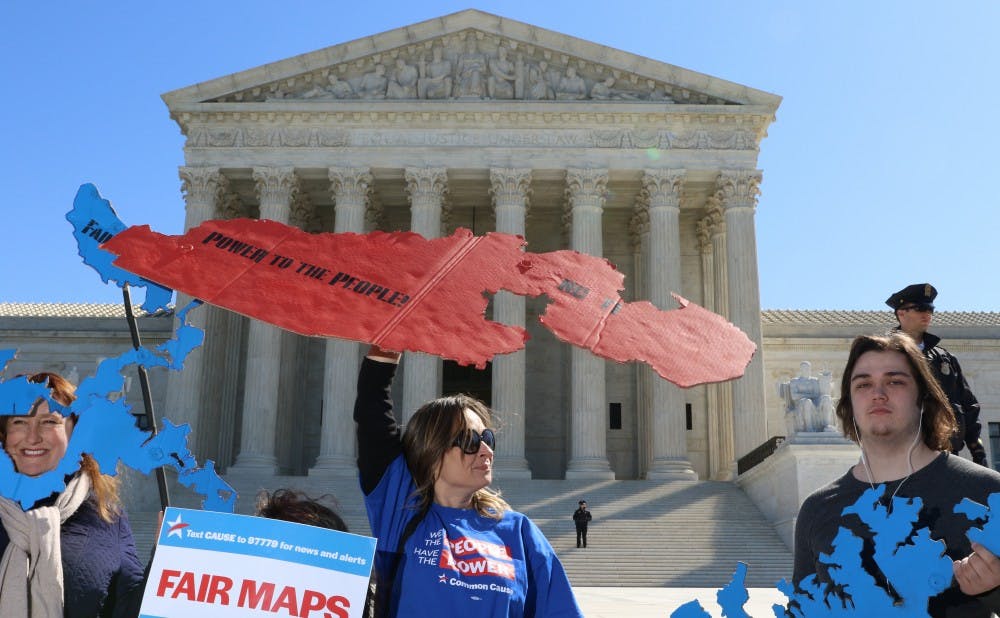WASHINGTON, D.C.—Three years ago, the Supreme Court upheld a ruling that forced North Carolina to redraw congressional districts to eliminate racial gerrymandering. Now, gerrymandering in North Carolina has made its way back to the Supreme Court.
Tuesday morning, the Court heard an oral argument for Rucho v. Common Cause, an appeal of a district court decision last year that struck down North Carolina’s 2016 congressional map for being an unconstitutional partisan gerrymander. Paul Clement, lawyer for the North Carolina Republicans, argued that plaintiffs originally had neither legal standing nor justiciable injury.
“What they're complaining of is that they're grouped in a district with either too many people who agree with them or too few people who agree with them, and, therefore, their vote is sort of diluted in some way,” Clement said.
Republican congressional candidates won only 53 percent of the statewide vote in 2016, but won 10 of 13 seats. This happened again in 2018.
Clement added that many voters live in districts where they will not have their preferred candidate elected.
Associate Justice Sonia Sotomayor disagreed that proportional representation was the issue at hand.
“All of the tests that they're proposing and that the district court looked at didn't talk about proportionate representation,” Sotomayor said. “It looked at only the opportunity to elect. An opportunity is different.”
She said that the way the map is structured limited opportunity for a party's supporters to elect their preferred representative.
The argument turned to research conducted by one of Duke's own—Jonathan Mattingly, chair of the department of mathematics. Mattingly and his colleagues developed a method to show whether a congressional map favors one party too much.
The appellee’s brief stated that Mattingly “generated over 24,000 alternative [congressional district] maps using traditional nonpartisan criteria. Fewer than 0.7 percent of them resulted in a Republican advantage as lopsided as 10-3.”
Clement pointed out that the small percentage is still a substantial number of maps.
“If you run 24,000 maps with partisanship taken out entirely and you just use traditional principles, you get 162 different maps that produce a 10/3 Republican split,” Clement said. “So, yeah, it's 1 percent, it's .7 percent—I mean .7 percent, just to be clear. That's 162 different ways to get to a 10/3 map that didn't take politics into account at all.”
Associate Justice Samuel Alito pointed out that there were no criteria for choosing among 24,000 maps. Sotomayor added that 99 percent of the time, the method produces maps fairer to both parties than the chosen map.
“You can have 162, 164, but what you can't do in picking that 1 percent of a map is discriminate against a group of people based on their political views,” she said. “You're discriminating on the basis of a group's speech and diluting their vote accordingly.”
Clement had pointed out that because there are 24,000 possible maps, the process should be discretionary, and left to the legislature.
“Well, that's making lemonade out of lemons,” Associate Justice Elena Kagan said. “You can do it 24,000 different ways and 23,999 produce an outcome that's less partisan than the one the legislature picked here.”
This too, was one point of the argument of Emmet Bondurant, lawyer for appellees Common Cause et al. He noted that in Mattingly’s charts, “six of the districts are extreme statistical outliers that would not be achieved in even one, in some instances, of 24,000 plans.” This, he said, demonstrates an “extreme partisan effect.”
“Isn’t proportional representation a judicially manageable standard?" Associate Justice Brett Kavanaugh asked Clement. Clement answered that it would require figuring out baselines.
Later on in the argument, Kavanaugh conceded that “gerrymandering is a real problem for our democracy,” but appeared wary to let the Court intervene.
“Have we really reached the moment, even though it would be a big lift for this Court to get involved, where the other actors can't do it?” Kavanaugh questioned.
Get The Chronicle straight to your inbox
Sign up for our weekly newsletter. Cancel at any time.

Earlier, Associate Justice Neil Gorsuch—also a President Donald Trump appointee—said that about 20 states had dealt with gerrymandering through citizen initiatives, which are ballot initiatives for creating nonpartisan redistricting commissions.
“The vast majority of states east of the Mississippi, including specifically North Carolina, do not have citizen initiative,” Bondurant said.
Later, Gorsuch added that there is also the state supreme court option. Allison Riggs, lawyer for appellees League of Women Voters of North Carolina, et al., rebutted that these other options don’t replace the Supreme Court’s duty to vindicate constitutional rights. She said that the Court's reputation is at much greater risk if it does nothing than if it does something.
Although there is a 5-4 conservative majority on the bench, some news outlets suggest there is potential for Kavanaugh to be a swing vote. His predecessor, Justice Anthony Kennedy, was known to be a swing vote on partisan gerrymandering before his retirement last year.
Kennedy's legacy also appeared in some of the questions current justices asked regarding whether it would be lawful for state lawmakers to pass a law requiring parties to create maps giving the majority party the advantage. In past writings, Kennedy had established the answer must be no.

